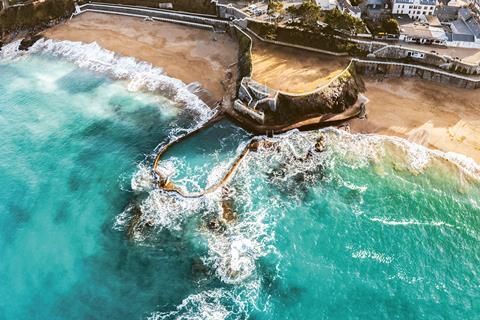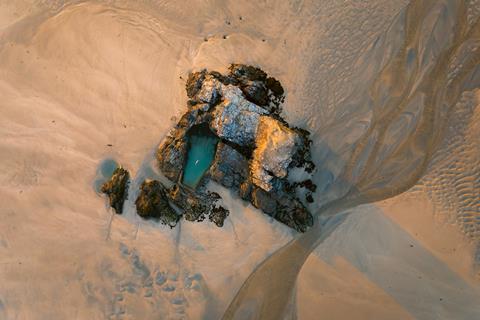A new book by Chris Romer-Lee explores the beauty and architectural significance of saltwater pools around the world

The sea can be challenging and changeable. Protected from the dangers of currents, crashing waves and extreme cold, sea pools (also known as tidal or ocean pools) are manmade pools that provide a safe space for swimmers to enjoy the benefits of the sea at all states of the tide and weather.
Sea Pools, a new book by Chris Romer-Lee, begins with an introduction to sea pools within the history of outdoor swimming, their unique designs and architectural significance and commentary on the resurgent appreciation for sea swimming in the 21st century.
Romer-Lee is the co-founder of architecture practice Studio Octopi. Chris was swimming in Lake Zurich when the idea for re-introducing swimming in the Thames was conceived as Thames Baths. He’s been working on tidal pool restoration projects in Scotland, a seawater lido in Cumbria as well as on swim sites abroad.
He has selected 66 of what he considers the most beautiful and culturally significant sea pools from around the world. Below are a selection of some of those pools from the book.
Piscine d’eau de mer Saint-Quay-Portrieux

Location Saint-Quay Portrieux, Brittany, France
Built 1929
Designer/Engineer M. Ronaze (engineer)
Size 25m long
Quinocéens are blessed with one of the most remarkable pools. This pear-shaped pool has sweeping curves accented with an exquisitely designed, cantilevered concrete diving platform. Unlike the rush of diving into Bon Secours, the leap into the emerald water is more gentil, reflecting the character of this picturesque town.
That said, there’s still scope for an audience. A large apron of sand forms the top of the headland, Châtelet. From this perspective the pool appears square, the tapered walls perfectly straightened by the line of sight and perspective. Access to the pool is from a grand staircase that plunges to the pool edge. All around are the emblematic white handrails that form part of the seaside improvements commissioned by the visionary mayor between the wars, Alfred Delpierre (1875–1957). To help deliver his vision, Delpierre appointed architect Yann Corlouër (1894–1980), who worked on much of the town’s Breton architecture. It’s unclear whether Corlouër had a hand in the pool, which is credited by the local tourist board to local engineer M. Ronaze.
The pool was constructed in only four months, which is impressive given the location. Initially there was a double-level diving board, but after a few accidents this was replaced by the one there today. Nestled between the pool and the beach is a further tidal pool. This one is shallow and makes a perfect children’s paddling pool as it is shielded from the swell by a smaller outcrop of rocks.
Chapel Rock

Location Perranporth, Cornwall
Built 1959
Designer/Engineer Messrs E. Thomas & Co.
Community Group Perranporth Bluetits
Chapel Rock, or Chapel Engarder as it is sometimes known, is a large rock in the bay at Perranporth, Cornwall. It is believed that a small chapel or oratory once stood on it. This chapel, or rather anchorite’s cell, was reportedly still on the rock as late as 1733. An account from E.W.F. Tomlin from 1922 noted there was evidence that its foundations were visible at this time. The location of the rock has long served as a breakwater protecting the village from the full force of stormy seas. However, the size of the rock has noticeably diminished as it has been relentlessly battered by the Atlantic over the years.
Nestled within the seaward side is a small tidal pool popular with both local and visiting bathers. The building of the pool was supported by local donations and Perranzabuloe Parish Council. It was first considered in the post-war period and was encouraged by the development of the Perranporth Surf Life Saving Club in 1957 when it became apparent that many residents did not know how to swim. The pool was constructed by Messrs E. Thomas & Co. and was in use by 19 October 1959.
In 1961, flagpoles were fitted on the beach and the flag of St Piran proudly flies on Chapel Rock. According to legend, St Piran, the patron saint of Cornwall, washed up on the beach at Perranporth. The flagpole acts as a reminder of St Piran’s pivotal role in the county.
Despite the continual battle with the influx of sand, the tidal pool remains popular with families taking their children to learn to swim and use their bodyboards, and with a wild-swimming group, Perranporth Bluetits, who retreat to it when the sea gets rough.
Piscinas Naturais de Porto Moniz

Location Porto Moniz, Madeira, Portugal
Built 1940
Size 3,800 sq. m, 2m deep
This ancient cluster of saltwater pools was formed by the flow and cooling of volcanic lava over thousands of years in the small coastal municipality of Porto Moniz on the north-west tip of Madeira. These natural formations were adapted in 1940 with the construction of a concrete seawall that merged the fragmented pools into one entity.
The project was commissioned by the municipal administration during one of the longest-surviving authoritarian regimes in Europe in the twentieth century, Portugal’s Estado Novo (‘new state’). The serpentine curves of smooth, white concrete that provide access to the water are evocative of central European modernism that was becoming increasingly popular across the continent. In fact, concrete was an unusual construction material in Portugal at this time, but the regime was keen to progress its own style of modernism. During the Estado Novo regime, citizens were obliged to provide community service and it’s thought the work to create the pools was undertaken by the residents of Porto Moniz.
Various updates were made through to April 1974 when the pool that we have today was completed. Although there is a small charge for entry to the pools, their scale and significance makes it worthy of inclusion. Further around the craggy coastline is Piscinas Naturais Velhas, which is in complete contrast to Piscinas Naturais de Porto Moniz. Enveloped within a lofty basalt terrain, these pools have high-level bridges and walkways for landlubbers to watch the more adventurous circumnavigate the pools. They’re also free.
Harmony Park

Location Strand, False Bay, Cape Town, South Africa
Built 1991–92
Designer/Engineer The Planning Partnership and Interplan Architects
Size 300 x 150 x 1.5m
The Harmony Park Resort was designed and built at a time when the apartheid Group Areas Act of 1950 and the Reservation of Separate Amenities Act of 1953 were still being enforced, despite growing opposition. This took the form of civil disobedience where campaigners used beaches they were forbidden to use. In August 1989, Archbishop Desmond Tutu defied orders from the apartheid government and led hundreds of protestors to picnic at ‘whites only’ Strand beach. Less than 2km away from Harmony Park Resort, at Strand Tutu declared, ‘We have proved these are God’s beaches.’
Although Harmony was completed just as South African beaches were being desegregated, the fact is this resort was designed for ‘coloured’ recreation and positioned as a buffer between the affluent ‘white’ beaches of Strand to the north and the ‘black’ beaches to the south.
The sensory experience of the wholly man-made Harmony Park tidal pool is like nothing else featured in this book. With a prevalent school of great white sharks off the coast, the pool was certainly necessary, and the experience didn’t disappoint when it opened with a sensory smorgasbord. Along with blow holes, concrete posts as ‘wave splitters’ were positioned along the top of the seawall converting the wave’s energy into a visual and audible display. The designer described the performance as ‘the sound of a riff played on a piano’.
Five islands across the pool feature plunge pools and fountains fed by pumped seawater. A raised seawall to the front edge means that it is never fully submerged by the tide; instead the perimeter walls to the left and right are lower and water circulation is via two spillways situated on either side of the tidal pool.
The pier is still intact, as is the majority of the tidal pool, however nature is never far from reclaiming pools in such exposed locations.
Curl Curl Rock Pools

Location Curl Curl, New South Wales
Built South 1927; North 1937
Size South 50 x 25m; North 25 x 20m
Community Group Cool Cats Winter Swimming Club; Frigid Frogs Swimming Club; Curl Curl Amateur Swimming Club
These are two contrasting pools positioned at either end of a beach in the northern suburbs of Sydney. The southern pool came first and was funded by the surf club, who raised the money through surf carnivals and social events. The pool opened in 1927 and was extended after just ten years. The wall running down the centre of the current pool marks the outer edge of the original pool. The extended pool formed a secondary area that was deeper and suitable for lengths. In another interesting development, the pool was shortened to 50m in 1966 to enable racing to be undertaken. This created the unique ‘stilling basin’ to the south-eastern edge. Like its sister pool, the rock plateau pops up in the pool, creating a natural divide between the two pools.
Curl Curl North Rock Pool is believed to be the only NSW ocean pool with a rocky outcrop in its centre. It is rare for a tidal pool to have been built on the north end of a bay, making it vulnerable to heavy seas and swells. However, both obscurities make this a particularly wild place, where the natural elements control who gets access and when. Ten years after it opened, the north pool was destroyed by heavy seas, and it wasn’t until around 1957 that it was rebuilt. Nowadays access is only achieved by foot from the headland. The restricted access means the pool is never cleaned; it is at the mercy of nature alone. In 2016 a large boulder the size of a minibus got washed into the pool during a storm, blocking the steps into the water. The pool was closed for an extended time to enable a temporary track to be built and heavy machinery to be brought in to break up the boulder.
Postscript
Sea Pools: 66 saltwater sanctuaries from around the world by Chris Romer-Lee is published by Batsford.















No comments yet